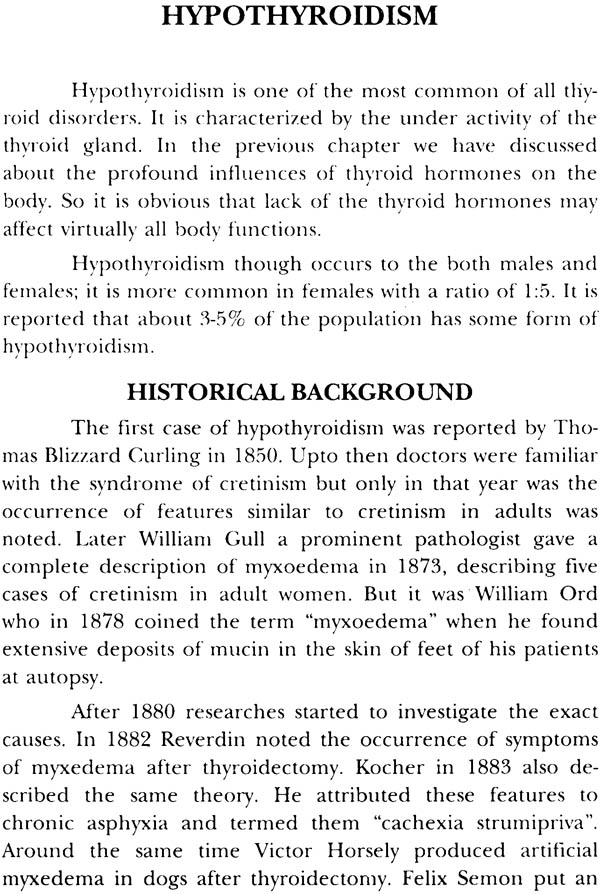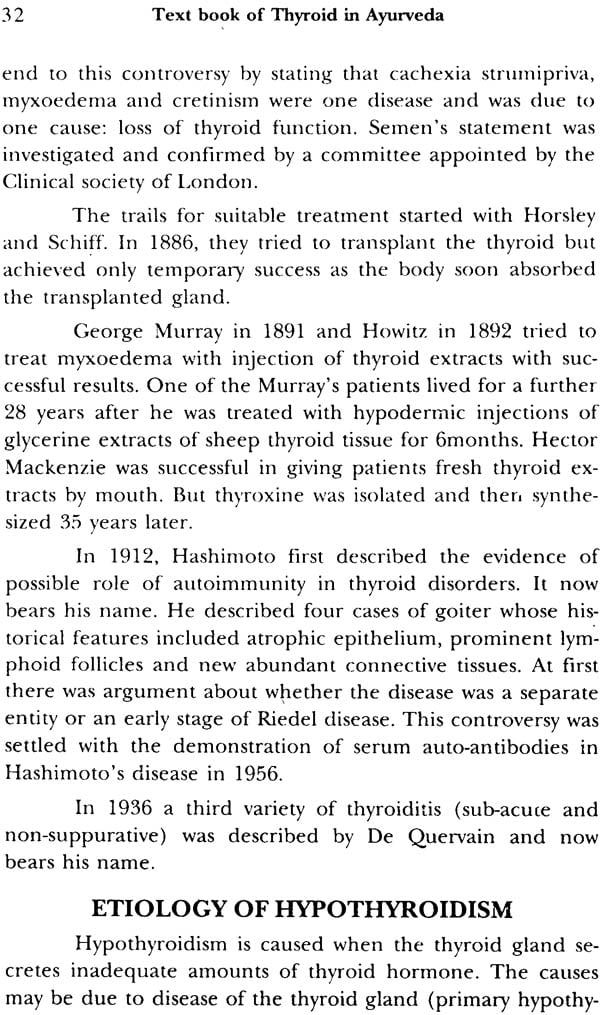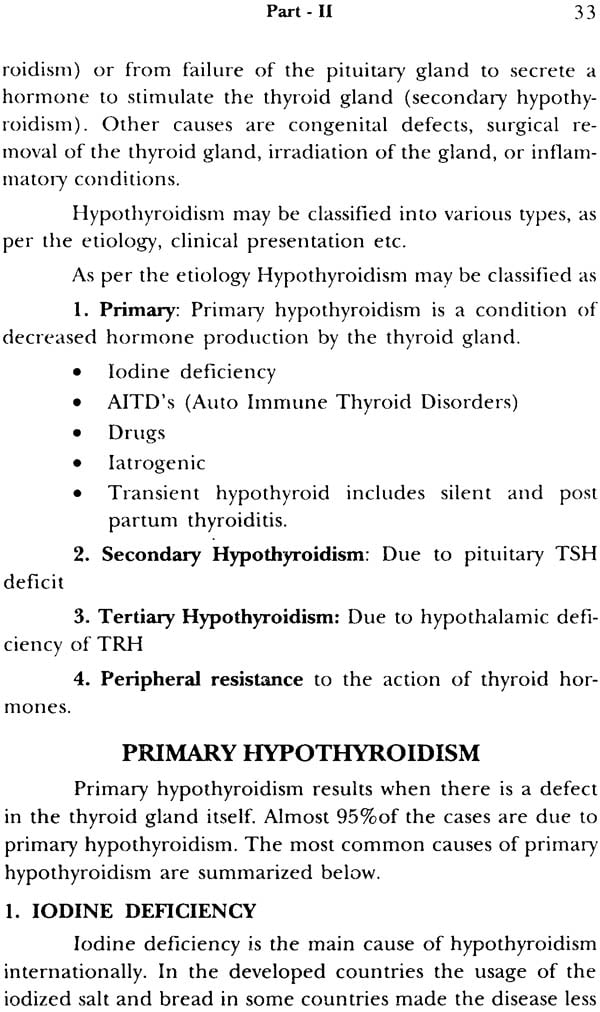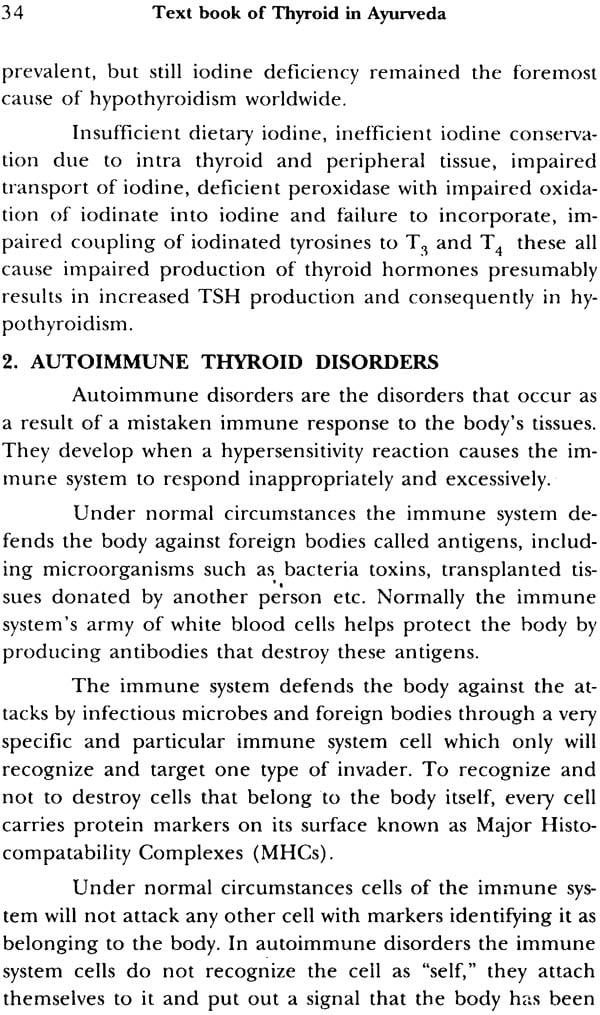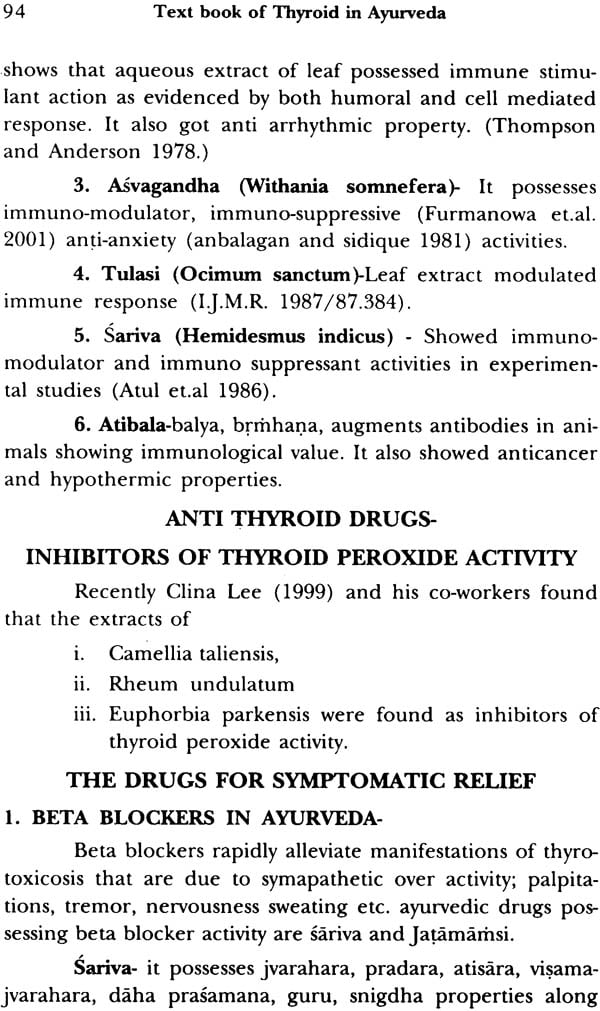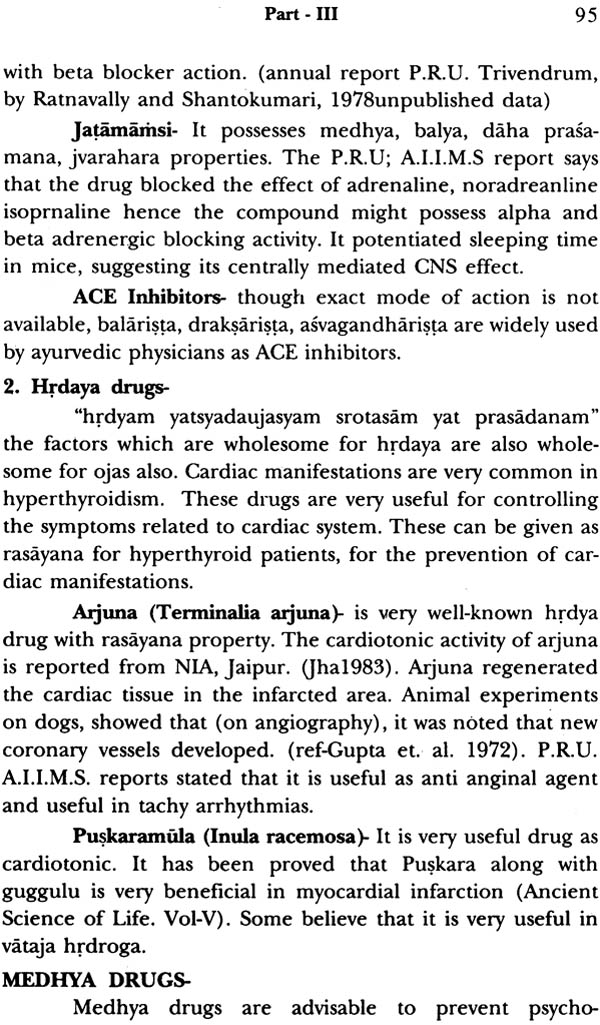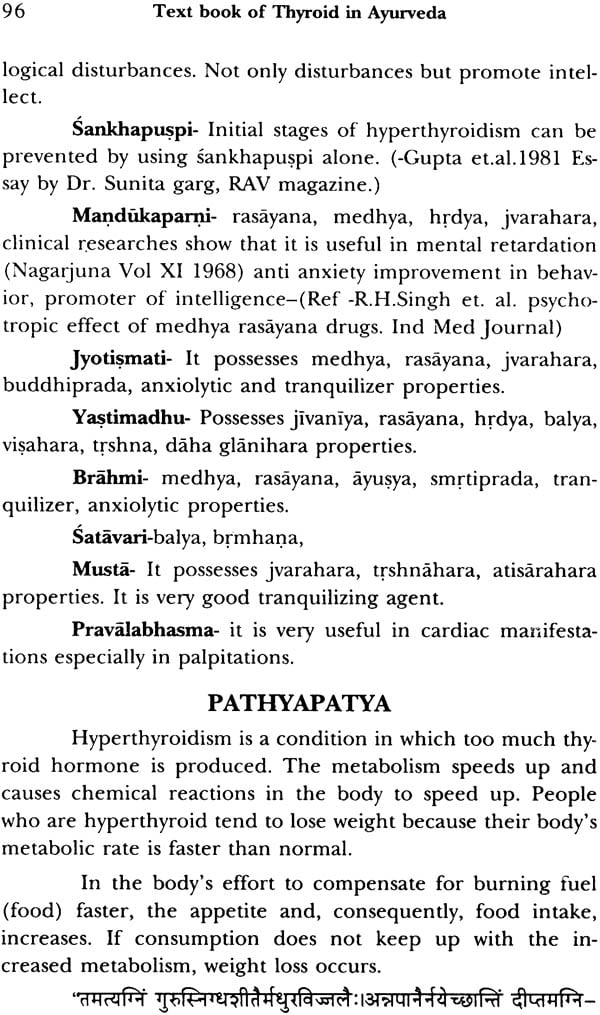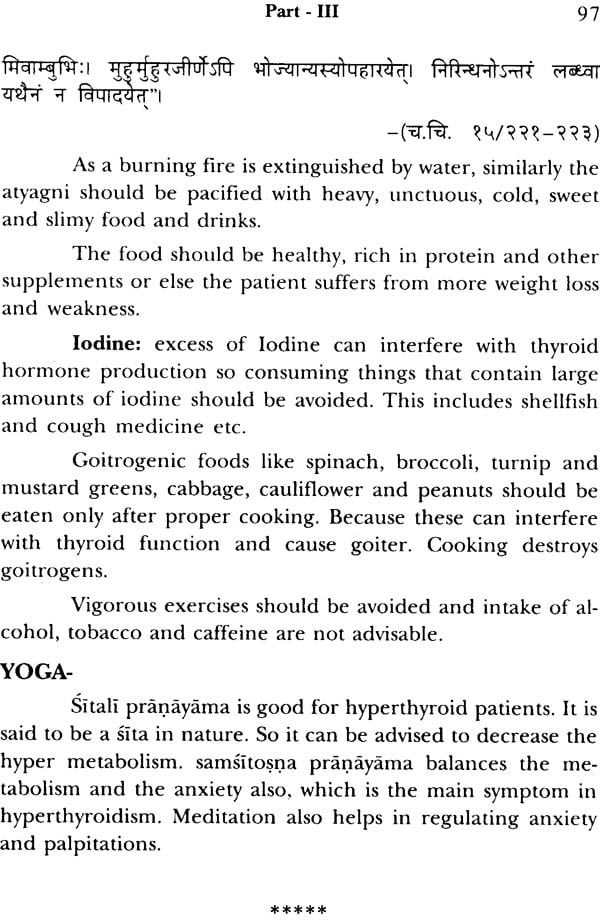
Text Book of Thyroid In Ayurveda
Book Specification
| Item Code: | NAC778 |
| Author: | Dr. V.V.L. Prasuna |
| Publisher: | Chowkhamba Sanskrit Series Office |
| Edition: | 2010 |
| ISBN: | 9788170803126 |
| Pages: | 150 (5 B/W Illustrations) |
| Cover: | Paperback |
| Other Details | 8.5 Inch X 5.5 Inch |
| Weight | 170 gm |
Book Description
Thyroid gland is one of the most important endocrine gland in the body. Until 17th century it was believed to have nothing more than the cosmetic role of making the neck more shapely. Thyroid hormones are very essential for normal metabolism growth and development. It is very sensitive and reacts to stress and stimuli very easily. So it is no wonder that thyroid disorders became the second most common endocrine disorder. Recent studies show that one out of 13 people are suffering with thyroid disorders and still more than half of the population is still unaware of it.
Due to inadequate success in combating the problem with other systems of medicine there is increasing demand to treat the disease with Ayurvedic system of medicine.
Many of the thyroid disorders are not life threatening and easily amicable to treatment. So it is attracting many Ayurvedic practitioners but the main obstacle is that there is no exact correlation of thyroid gland in Ayurveda and many Ayurvedic Practitioners are adopting a vague approach by simply prescribing Kanchanara Guggulu or call all the thyroid disorders as Galaganda which is giving successful results some times and sometimes not.
Ayurvedic system of medicine is very futuristic and it has solutions even to the forthcoming disorders. Caraka emphasized that nomenclature of the diseases is not much necessary to treat the disease rather he insists on diagnosis of the constitutional status and plan the treatment accordingly.
Approach to the thyroid gland is better understood by the actions of the thyroxine on the body rather than the anatomical location. The main action of thyroid hormone is to act as a spark to pep-up body metabolism. In ayurveda parlance it can be correlated with the actions of Agni.
Understanding the disease and the constitutional status of the disease is very important for planning the treatment and applying the Ayurvedic treatment principles. For that the etiology clinical features and their types are mentioned here.
An attempt has been made to elaborate the treatment principles about the thyroid disorders without distracting the basic philosophy and precincts of Ayurveda for almost all types of thyroid disorders.
This book will surely beneficial to all the Ayurvedic practitioners students research persons and all those who are interested in science.
Thyroid disorders are the most common diseases we see in daily practice. As mentioned in foreword, many of the thyroid diseases are amicable to treatment and many patients are also very much interested towards ayurveda. But unfortunately there is no direct mention of thyroid gland in Ayurveda.
But Ayurvedic system of medicine is very futuristic and Caraka in 18th chapter of Sutra sthana emphasized that. There is no need to emphasize on the exact nomenclature of the disease. On the contrary Caraka insists on diagnosis of the constitutional status and plan the treatment of the disease.
Susruta also quoted similar text Madhava Nidana also given the priority of the knowledge of disease before going for the treatment.
Breaking the chain of etio-pathogenesis) is the main line of treatment principle mentioned in Ayurveda. For that also it is very essential to have a good command over the disease.
Understanding the disease is very important for applying the Ayurvedic treatment principles and to treat the disease successfully. For that etiology and pathogenesis have been mentioned.
Among thyroid disorders hypothyroidism, is very amicable to Ayurvedic treatment. Careful monitoring of the thyroid levels and other clinical symptoms and complications is necessary as any other disease. The second most common in Ayurvedic clinical practice is goiter. In goiters grade I and II respond well with Ayurvedic treatment. The third one is Hyperthyroidism. It is comparatively difficult to treat if it be comes chronic.
Physiological and pathological aspects of thyroid gland are mentioned and selection of the drugs as per the condition is discussed elaborately.
Nervous system and the endocrine systems are the major controlling systems of the body. The nervous system communicates using neurons and electricity the endocrine system uses chemicals called hormones to communicate between cells and regulate body functions.
Endocrine glands do not have a duct system and are called ductless glands. These glands release hormones directly into the blood or lymph. Endocrine glands have a rich blood supply through which hormones travel to reach their target organs. These glands include the pituitary gland the pineal gland the hypothanlamus the thyroid gland the parathyroid glands, the thymus the adrenal glands, the ovaries (in females) or tests (in males) and the Pancreas.
The endocrine system helps regulate and maintain various body functions by synthesizing and releasing hormones chemical messengers. The major areas of control and integration include responses to stress and injury growth and development absorption of nutrients energy metabolism water and electrolyte balance reproduction birth and lactation.
Hormones are named from the Greek word Hormo meaning to urge or excite because they were first discovered to play a role in hunger, sex, fight or flight response and many other basic drives.
Thyroid gland is one of the major endocrine gland in the body. It is a butterfly shaped gland situated in the lower part of the neck and produces three hormones thyroxine (T4) and tri-iodothyronine (T3) and calcitonin. T3 and T4 are collectively called thyroid hormone and are produced in the follicles of the thyroid gland. Parafollicular cells (C. Cells) between the thyroid gland follicles produce calcitonin which regulates the calcium levels in the body normal.
| Part I | |
| Introduction | 3 |
| Historical Aspects | 4 |
| Anatomy of thyroid gland | 5 |
| Development of Thyroid Gland | 7 |
| Histology of Thyroid Gland | 8 |
| Thyroid hormone synthesis | 10 |
| Metabolism of Thyroid hormones | 15 |
| Physiological actions of thyroid hormones | 15 |
| Significance of Iodine | 18 |
| Thyroxine in Ayurveda Parlance | 20 |
| Control of Thyroxine | 22 |
| Investigations | 24 |
| Part II | |
| Hypothyroidism | 31 |
| Historical aspects | 31 |
| Etiology of Hypothyroidism | 33 |
| Primary Hypothyroidism | 34 |
| Hashimotos Thyroiditis | 36 |
| Secondary and Tertiary Hypothyroidism | 38 |
| Congenital Hypothyroidism | 40 |
| Pendred’s syndrome | 41 |
| Juvenile Hypothyroidism | 41 |
| Clinical Features of Hypothyroidism | 42 |
| Pathology | 4 7 |
| Hypothyroidism in Ayurveda | 49 |
| Sadhyasadhya | 55 |
| Chikitsa Yojana | 58 |
| Pathyapathya | 59 |
| Part III | |
| Hyperthyroidism | 65 |
| Historical aspects | 65 |
| Etiology of Hyperthyroidism | 67 |
| Graves diseases | 67 |
| Clinical features of hyperthyroidism | 75 |
| Pathology of Hyperthyroidism | 81 |
| Hyperthyroidism in Ayurveda wsr to bhasmaka | 87 |
| Sadhyasadhya | 91 |
| Chikitsa Yojana | 92 |
| Pathyapathya | 96 |
| Part IV | |
| Goiter | 101 |
| Historical Aspects | 101 |
| Etiology and types of goiter | 102 |
| Pathogenesis of goiter | 103 |
| Galaganda | 110 |
| Sadhyasadhya | 116 |
| Chikitsa Yojana | 117 |
| Pathyapathya | 118 |
| Appendix | |
| Some Useful drugs in Hypothyroidism | 123 |
| Some Useful drugs in Hyperthyroidism | 126 |
| Some Useful drugs in goiter | 129 |
| References | 133 |
| Alphabetical Index | 138 |
